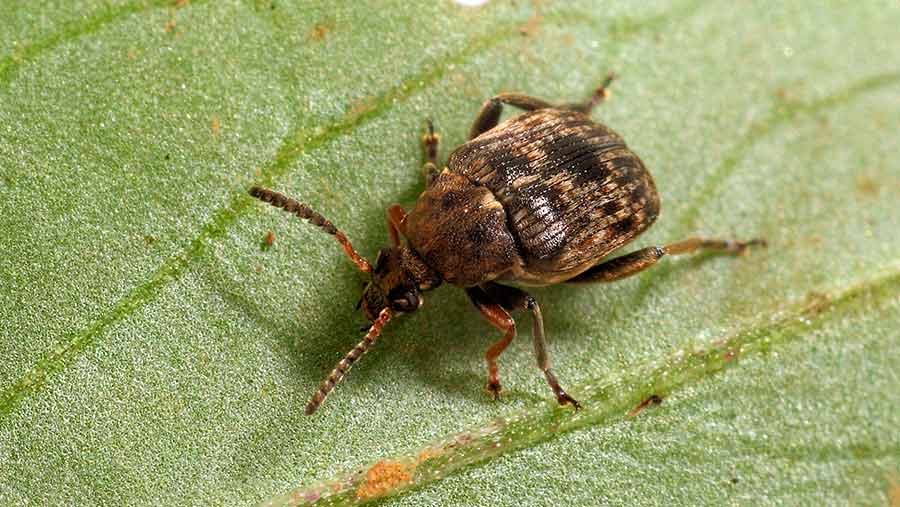5 easy steps to tackling bruchid beetle damage
Bean growers can lose out on valuable premiums for the human consumption market because of bruchid beetle damage.
To help avoid a costly downgrade to feed bean pricesr, Crops picked up some useful tips on how to minimise the damage caused by bruchid beetle from Becky Ward, principal technical officer at the Processors and Growers Research Organisation (PGRO).

Bruchid beetle damage on spring bean seeds
See also: 8 top tips to crack down on volunteer oilseed rape plants
She flags up five key points for bean growers to consider when trying to reduce the level of crop damage caused by the pest, including drilling later and spraying at the right time with an optimum rate.
1. Temperature

Bruchid beetle eggs on a spring bean pod
Two consecutive days at 20C coinciding with first pod set will trigger bruchid beetle egg laying, says Ms Ward. This is when a pesticide spray is needed.
“You need to wait for the bottom pods to set about 1-2cm long, just exposed from the flower.
“East Anglia has historically been the worst affected by the pest, but the area has seen the greatest uptake of this advice since it came out in 2008 and it seems to be working well in recent years, with damage falling.”
As a result, East Anglia is no longer the area that suffers the highest level of bruchid beetle damage. Crops in the Midlands now see a higher rate of pest attack, she adds.
2. Check the label

© Blackthorn Arable
Ms Ward reminds growers to check insecticide labels for restrictions on use in a flowering crop.
She highlights that bean growers have only pyrethroid chemistry at their disposal when spraying for bruchid beetle and while there is no resistance in the pest yet, this shouldn’t be taken for granted.
“Make sure you don’t drop your insecticide rates, as this will encourage pyrethroid resistance to build up in bruchid beetle.”
3. Spray timings

© Tim Scrivener
It may be tricky to forecast when temperatures will reach 20C for two consecutive days, so Ms Ward advocates using the Syngenta BruchidCast forecasting service.
Growers can register for free on Syngenta’s website to get the latest information on temperatures and opportunities to spray.
See also: The ultimate guide to pest and disease forecasting
“This tool is really handy for timing your sprays,” says Ms Ward. “Once the required temperature threshold is hit, growers should check their bean crops to ensure they are at the first-pod-set stage.”
She adds that crops should be sprayed early in the morning or late at night to avoid any harm to bees.
4. Nozzles and rates

© Tim Scrivener
Ms Ward recommends using forward-backward angled nozzles to get a good spray coverage in the crop, particularly in dense crops where canopy penetration may be more difficult.
In addition to always using full rates of pyrethroids, she says growers need to be using the best water rates to help maximise bruchid beetle control.
“Previous work with Syngenta investigated the use of different water rates and we found that there is no advantage of using greater than 200 litres/ha of water.
“However, dropping below 100 litres/ha in some cases could be detrimental to spray coverage,” she says.
5. Drill date

© Tim Scrivener
Research conducted by the PGRO across three sites with untreated crops found bruchid beetle damage was halved when spring beans were drilled in early April, compared with early March.
“Even drilling at the end of March sees about a 10% reduction in pest damage,” Ms Ward explains. “This is due to time of flowering and pod-set in the crop. There are very significant differences between the unsprayed plots.”
The PGRO trials showed 10% bruchid damage to harvested seeds when crops were drilled in early April, 19% damage in crops drilled in late March and 26.5% in crops drilled in early March.

